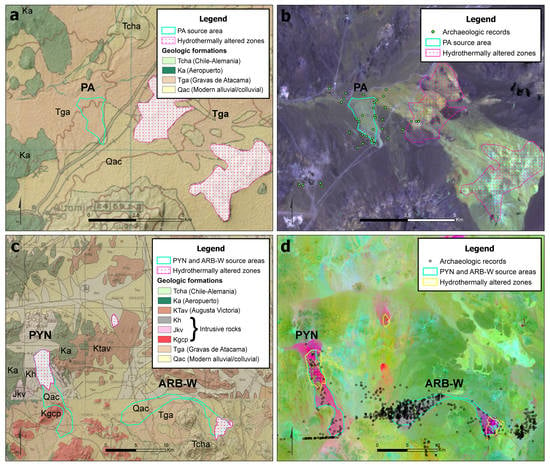Beyond Site Detection: The Role of Satellite Remote Sensing in Analysing Archaeological Problems. A Case Study in Lithic Resource Procurement in the Atacama Desert, Northern Chile
Abstract
1. Introduction
2. Satellite Remote Sensing in Problem-Oriented Research
3. Introduction to the Case Study: Research Problem and Background
3.1. Lithic Procurement Strategies in Hunter-Gatherer Societies
3.2. Satellite Imagery and the Mapping of Lithic Source Areas
4. Study Area: Physical and Archaeological Setting
5. Materials and Methods
5.1. Construction of a Georeferenced Database
- UTM coordinates (WGS84 datum)
- site category
- horizontal extension (area)
- type and number of lithic artefacts recorded
- type of lithic raw materials recorded
5.2. Satellite Image Analysis
5.3. Archaeological Fieldwork
5.4. GIS Integration
6. Results
6.1. From the “Grey Literature” to the GIS Database
6.2. Satellite Remote Sensing the Lithic Landscape
6.2.1. Band Combinations
6.2.2. Band Ratios
6.2.3. PCA
6.3. Stepping Inside the Core of the Atacama Desert
7. Discussion
8. Conclusions
Supplementary Materials
Author Contributions
Funding
Acknowledgments
Conflicts of Interest
References
- Dimitrios, A.; Agapiou, A.; Diofantos, H.; Sarris, A. Remote Sensing Applications in Archaeological Research. In Remote Sensing—Applications; Escalante, B., Ed.; InTech: London, UK, 2012. [Google Scholar]
- Comer, D.C.; Harrower, M.J. Mapping Archaeological Landscapes from Space; Springer: New York, NY, USA, 2013. [Google Scholar]
- Forte, M.; Campana, S. (Eds.) Digital Methods and Remote Sensing in Archaeology. Archaeology in the Age of Sensing; Springer: New York, NY, USA, 2016. [Google Scholar]
- Rowan, L.C.; Wetlaufer, P.H.; Goetz, A.F.H.; Billingsley, F.C.; Stewart, J.H. Discrimination of Rock Types and Detection of Hydrothermally Altered Areas in South-Central Nevada by the Use of Computer-Enhanced ERTS Images; U.S. Govt. Print. Off.: Washington, DC, USA, 1974.
- Abrams, M.J.; Brown, D.; Lepley, L.; Sadowski, R. Remote sensing for porphyry copper deposits in southern Arizona. Econ. Geol. 1983, 78, 591–604. [Google Scholar] [CrossRef]
- Sultan, M.; Arvidson, R.E.; Sturchio, N.C.; Guinness, E.A. Lithologic mapping in arid regions with Landsat thematic mapper data: Meatiq dome, Egypt. GSA Bull. 1987, 99, 748–762. [Google Scholar] [CrossRef]
- Sabins, F. Remote sensing for mineral exploration. Ore Geol. Rev. 1999, 14, 157–183. [Google Scholar] [CrossRef]
- Gad, S.; Kusky, T. Lithological mapping in the Eastern Desert of Egypt, the Barramiya area, using Landsat thematic mapper (TM). J. Afr. Earth Sci. 2006, 44, 196–202. [Google Scholar] [CrossRef]
- Van der Meer, F.D.; van der Werff, H.M.A.; van Ruitenbeek, F.J.A.; Hecker, C.A.; Bakker, W.H.; Noomen, M.F.; van der Meijde, M.; Carranza, E.J.M.; Smeth, J.B.D.; Woldai, T. Multi- and hyperspectral geologic remote sensing: A review. Int. J. Appl. Earth Obs. Geoinf. 2012, 14, 112–128. [Google Scholar] [CrossRef]
- Goodyear, A. A Hypothesis for the Use of Cryptocrystalline Raw Materials Among Paleo-Indian Groups of North America; Research Manuscript Series; 1979; Available online: https://scholarcommons.sc.edu/cgi/viewcontent.cgi?referer=https://scholar.google.com.hk/&httpsredir=1&article=1126&context=archanth_books. (accessed on 10 April 2019).
- Gardner, W.M. Stop me if you’ve Heard This one Before: The Flint Run Complex Revisited. Archaeol. East. N. Am. 1983, 11, 49–64. [Google Scholar]
- Gould, R.A.; Saggers, S. Lithic Procurement in Central Australia: A Closer Look at Binford’s Idea of Embeddedness in Archaeology. Am. Antiq. 1985, 50, 117–136. [Google Scholar] [CrossRef]
- Bamforth, D.B. Technological Efficiency and Tool Curation. Am. Antiq. 1986, 51, 38–50. [Google Scholar] [CrossRef]
- Andrefsky, W. Raw-material availability and the organization of technology. Am. Antiq. 1994, 59, 21–34. [Google Scholar] [CrossRef]
- Bailey, G. Concepts, time-scales and explanations in economic prehistory. In Economic Archaeology: Towards an Integration of Ecological and Social Approaches; Sheridan, A., Bailey, G., Eds.; British Archaeological Reports: Oxford, UK, 1981; pp. 97–117. [Google Scholar]
- Foley, R. A Model of Regional Archaeological Structure. Proc. Prehist. Soc. 1981, 47, 1–17. [Google Scholar] [CrossRef]
- Dunnell, R.; Dancey, W. The siteless survey: A Regional scale data collection strategy. Adv. Archaeol. Method Theory 1983, 6, 267–287. [Google Scholar]
- Barrientos, G.; Catella, L.; Oliva, F. The Spatial Structure of Lithic Landscapes: The Late Holocene Record of East-Central Argentina as a Case Study. J. Archaeol. Method Theory 2015, 22, 1151–1192. [Google Scholar] [CrossRef]
- Carr, T.; Turner, M. Investigating regional lithic procurement using multi-spectral imagery and geophysical exploration. Turner 1996, 3, 109–127. [Google Scholar] [CrossRef]
- Rosendahl, S. Lithic Procurement Stategies in Early Prehitoric Cyprus: A Predictive Model. Master’ s Thesis, University of Leicester, Leicester, UK, 2010. [Google Scholar]
- Deroin, J.-P.; Téreygeol, F.; Heckes, J. Evaluation of very high to medium resolution multispectral satellite imagery for geoarchaeology in arid regions—Case study from Jabali, Yemen. J. Archaeol. Sci. 2011, 38, 101–114. [Google Scholar] [CrossRef]
- Vining, B. Reconstructions of local resource procurement networks at Cerro Baúl, Peru using multispectral ASTER satellite imagery and geospatial modeling. J. Archaeol. Sci. Rep. 2015, 2, 492–506. [Google Scholar] [CrossRef]
- Parish, R.M. Reflectance Spectroscopy as a Chert Sourcing Method. Archaeol. Pol. 2016, 54, 115–128. [Google Scholar]
- Thompson, V.D.; Arnold, P.J.; Pluckhahn, T.J.; Vanderwarker, A.M. Situating Remote Sensing in Anthropological Archaeology. Archaeol. Prospect. 2011, 18, 195–213. [Google Scholar] [CrossRef]
- Banaszek, Ł.; Cowley, D.C.; Middleton, M. Towards National Archaeological Mapping. Assessing Source Data and Methodology—A Case Study from Scotland. Geosciences 2018, 8, 272. [Google Scholar] [CrossRef]
- Agapiou, A.; Hadjimitsis, D.G.; Georgopoulos, A.; Sarris, A.; Alexakis, D.D. Towards an Archaeological Index: Identification of the Spectral Regions of Stress Vegetation due to Buried Archaeological Remains. In Progress in Cultural Heritage Preservation; Springer: Berlin/Heidelberg, Germany, 2012; pp. 129–138. [Google Scholar]
- Cerra, D.; Agapiou, A.; Cavalli, R.M.; Sarris, A. An Objective Assessment of Hyperspectral Indicators for the Detection of Buried Archaeological Relics. Remote Sens. 2018, 10, 500. [Google Scholar] [CrossRef]
- Fradley, M.; Sheldrick, N. Satellite imagery and heritage damage in Egypt: A response to Parcak et al. (2016). Antiquity 2017, 91, 784–792. [Google Scholar] [CrossRef]
- Verhoeven, G. Are We There Yet? A Review and Assessment of Archaeological Passive Airborne Optical Imaging Approaches in the Light of Landscape Archaeology. Geosciences 2017, 7, 86. [Google Scholar] [CrossRef]
- Harrower, M.; McCorriston, J.; Oches, E.A. Mapping the roots of agriculture in southern Arabia: The application of satellite remote sensing, global positioning system and geographic information system technologies. Archaeol. Prospect. 2002, 9, 35–42. [Google Scholar] [CrossRef]
- Siart, C.; Eitel, B.; Panagiotopoulos, D. Investigation of past archaeological landscapes using remote sensing and GIS: A multi-method case study from Mount Ida, Crete. J. Archaeol. Sci. 2008, 35, 2918–2926. [Google Scholar] [CrossRef]
- Salvi, M.C.; Salvini, R.; Cartocci, A.; Kozciak, S.; Gallotti, R.; Piperno, M. Multitemporal analysis for preservation of obsidian sources from Melka Kunture (Ethiopia): Integration of fieldwork activities, digital aerial photogrammetry and multispectral stereo-IKONOS II analysis. J. Archaeol. Sci. 2011, 38, 2017–2023. [Google Scholar] [CrossRef]
- Parcero-Oubiña, C.; Fábrega-Álvarez, P.; Salazar, D.; Troncoso, A.; Hayashida, F.; Pino, M.; Borie, C.; Echenique, E. Ground to air and back again: Archaeological prospection to characterize prehispanic agricultural practices in the high-altitude Atacama (Chile). Quat. Int. 2017, 435 Pt B, 95–110. [Google Scholar] [CrossRef]
- Smith, S.L.; Chambrade, M.-L. The Application of Freely-Available Satellite Imagery for Informing and Complementing Archaeological Fieldwork in the “Black Desert” of North-Eastern Jordan. Geosciences 2018, 8, 491. [Google Scholar] [CrossRef]
- Lamenza, G. GIS and remote sensing in the archaeological research of the Argentine Chaco. Arqueol. Iberoam. 2015, 27, 40–54. [Google Scholar]
- Dellepiane, J. Uso de imágenes satelitales para el reconocimiento de parapetos en el centro-oeste de Patagonia meridional. Arqueologia 2018, 24, 259–269. [Google Scholar]
- Bognanni, F. La teledetección aplicada al estudio del pasado a una escala inter-regional. Rev. Española Antropol. Am. 2010, 40, 77–93. [Google Scholar]
- Binford, L.R. Organization and formation processes: Looking at curated technologies. J. Anthropol. Res. 1979, 36, 255–273. [Google Scholar] [CrossRef]
- Kelly, R.L. The Three Sides of a Biface. Am. Antiq. 1988, 53, 717–734. [Google Scholar] [CrossRef]
- Nelson, M. The study of technological organization. In Archaeological Method and Theory; Schiffer, M., Ed.; University of Arizona Press: Tucson, Arizona, 1991; pp. 57–100. [Google Scholar]
- Roth, B.J. Mobility, Technology, and Archaic Lithic Procurement Strategies in the Tucson Basin. Kiva 1998, 63, 241–262. [Google Scholar] [CrossRef]
- Binford, L.R. An Archaeological Perspective; Seminar Press: New York, NY, USA, 1972. [Google Scholar]
- Odell, G. Economizing Behavior and the Concept of “Curation”. In Stone Tools. Theoretical Insights into Human Prehistory; Plenum Press: New York, NY, USA, 1996; pp. 51–80. [Google Scholar]
- Beck, C.; Taylor, A.; Jones, G.; Fadem, C.; Cook, C.; Millward, S. Rocks are heavy: Transport costs and Paleoarchaic quarry behavior in the Great Basin. J. Anthropol. Archaeol. 2002, 21, 481–507. [Google Scholar] [CrossRef]
- Núñez, L. Secuencia de asentamientos prehistóricos del área de Taltal. En Tres ensayos para una historia de Taltal y su zona. Rev. Futuro 1984, 8, 28–76. [Google Scholar]
- Urrejola, C.; Orellana, M. Explotación y Utilización de Recursos Líticos de la Zona Desértica al Interior de Tal-Tal; Universidad de Chil: Santiago, Chile, 1999. [Google Scholar]
- Castelleti, J. Patrón de Asentamiento y uso de Recursos a Través de la Secuencia Ocupacional Prehispana en la Costa de Taltal; Universidad Católica del Norte-Universidad de Tarapacá: Arica, Chile, 2007. [Google Scholar]
- Blanco, J.F.; de la Maza, M.; Rees, C. Cazadores Recolectores Costeros y el Aprovisionamiento de Recursos Líticos. Perspectivas Interpretativas de los Eventos de Talla en el Desierto Absoluto. Rev. Werkén 2010, 13, 45–68. [Google Scholar]
- Pimentel, G.; Rees, C.; De Souza, P.; Arancibia, L. Viajeros costeros y caravaneros. Dos estrategias de movilidad en el Período Formativo del desierto de Atacama, Chile. In En Ruta. Arqueología, Historia y Etnografía del tráfico Sur Andino; Núñez, L., Nielsen, A., Eds.; Encuentro Grupo Editor: Córdoba, Argentina, 2011; pp. 43–81. [Google Scholar]
- Salazar, D.; Figueroa, V.; Andrade, P.; Salinas, H.; Olguín, L.; Power, X.; Rebolledo, S.; Parra, S.; Orellana, H.; Urrea, J. Cronología y organización económica de las poblaciones arcaicas de la costa de Taltal. Estud. Atacameños 2015, 50, 7–46. [Google Scholar] [CrossRef]
- Power, X.; Arenas, C.; Monroy, I.; Traverso, F.; Galarce, P.; Parra, S. Informe Lítica Proyecto Fondecyt 1151203, Unpublished manuscript, Santiago, Chile. 2019.
- Ballester, B.; Crisóstomo, M. Percutores de la Pampa del Desierto de Atacama (Norte de Chile): Tecnología, Huellas de Uso, Decoración y Talladores. Chungara 2017, 49, 175–192. [Google Scholar] [CrossRef]
- Borie, C.; Power, X.; Parra, S.; Salinas, H.; Rostan, P.; Galarce, P.; Peña, I.; Traverso, F. Tras la Huella del Sílice Pampino. Nuevas Metodologías para el Rastreo de las Áreas Fuente de Aprovisionamiento lítico en Taltal. Estud. Atacameños 2017, 56, 103–131. [Google Scholar] [CrossRef][Green Version]
- Borie, C.; Salazar, D.; Power, X.; Figueroa, M.J.; Orellana, H.; Parra, S.; Arenas, C.; Traverso, F.; Monroy, I. Cazadores-Recolectores Marítimos en la Pampa Desértica de Taltal. Conocimientos, Recursos, Prácticas Sociales y Territorialización. In Estudios de Arqueología, Historia, Filosofía y Ciencias Sociales. En Homenaje a Mario Orellana Rodriguez (60 Años de Vida Académica y Científica); Orellana, F., Ed.; Ediciones del Desierto: San Pedro de Atacama, Antofagasta, Chile, 2017; pp. 205–242. [Google Scholar]
- Dunai, T.J.; González López, G.A.; Juez-Larré, J. Oligocene–Miocene Age of Aridity in the Atacama Desert Revealed by Exposure Dating of Erosion-Sensitive Landforms. Geology 2005, 33, 321–324. [Google Scholar] [CrossRef]
- Houston, J. Variability of Precipitation in the Atacama Desert: Its Causes and Hydrological Impact. Int. J. Climatol. 2006, 26, 2181–2198. [Google Scholar] [CrossRef]
- Placzek, C.; Quade, J.; Betancourt, J.L.; Patchett, P.J.; Rech, J.A.; Latorre, C.; Matmon, A.; Holmgren, C.; English, N.B. Climate in the dry central andes over geologic, millennial, and interannual timescales. Ann. Mo. Bot. Gard. 2009, 96, 386–397. [Google Scholar] [CrossRef]
- Amundson, R.; Dietrich, W.; Bellugi, D.; Ewing, S.; Nishiizumi, K.; Chong, G.; Owen, J.; Finkel, R.; Heimsath, A.; Stewart, B.; et al. Geomorphologic Evidence for the Late Pliocene Onset of Hyperaridity in the Atacama Desert. Gsa Bull. 2012, 124, 1048–1070. [Google Scholar] [CrossRef]
- Chuvieco, E. Teledetección Ambiental; Ariel: Barcelona, Spain, 2006. [Google Scholar]
- Hunt, G. Spectral Signatures of Particulate Minerals in the Visible and Near Infrared. Geophysics 1977, 42, 501–513. [Google Scholar] [CrossRef]
- Clark, R.; King, T.; Klejwa, M.; Swayze, G.; Vergo, N. High spectral resolution reflectance spectroscopy of minerals. J. Geophys. Res. 1990, 95, 12653–12680. [Google Scholar] [CrossRef]
- Carranza, E.J.M.; Hale, M. Mineral imaging with Landsat Thematic Mapper data for hydrothermal alteration mapping in heavily vegetated terrane. Int. J. Remote Sens. 2002, 23, 4827–4852. [Google Scholar] [CrossRef]
- Cattáneo, R.; Di Lello, C.; Gómez, J.C. Cuantificación y análisis de la distribución de rocas útiles para la manufactura de instrumentos a través del uso de Sistemas de Información Geográfica (SIG) en el área de Piedra Museo, Santa Cruz, Argentina. In El uso de Sistemas de Información Geográfica en Arqueología Sudamericana; Figuerero, M.J., Izeta, A., Eds.; Archaeopress: Oxford, UK, 2013; pp. 43–60. [Google Scholar]
- Goudie, A.S. Arid and Semi-Arid Geomorphology; Cambridge University Press: New York, NY, USA, 2013. [Google Scholar]
- Ortlieb, L.; Vargas, G.; Saliége, J. Marine radiocarbon reservoir effect along the northern Chile–southern Peru coast (14–24°S) throughout the Holocene. Quat. Res. 2011, 75, 91–103. [Google Scholar] [CrossRef]
- Marquet, P.A.; Bozinovic, F.; Bradshaw, G.A.; Cornelius, C.; González, H.; Gutiérrez, J.R.; Hajek, E.R.; Lagos, J.A.; López-Cortes, F.; Núñez, L.; et al. Los Ecosistemas del Desierto de Atacama y Área Andina Adyacente en el Norte de Chile. Rev. Chil. Hist. Nat. 1998, 71, 593–617. [Google Scholar]
- Vargas, G.; Rutllant, J.; Ortlieb, L. ENSO Tropical–Extratropical Climate Teleconnections and Mechanisms for Holocene Debris Flows Along the Hyperarid Coast of Western South America (17°–24°S). Earth Planet. Sci. Lett. 2006, 249, 467–483. [Google Scholar] [CrossRef]
- Herrera, C.; Custodio, E. Origin of waters from small springs located at the northern coast of Chile, in the vicinity of Antofagasta. Andean Geol. 2014, 41, 314–341. [Google Scholar]
- Placzek, C.; Matmon, A.; Granger, D.; Quade, J.; Niedermann, S. Evidence for active landscape evolution in the hyperarid Atacama from multiple terrestrial cosmogenic nuclides. Earth Planet. Sci. Lett. 2010, 295, 12–20. [Google Scholar] [CrossRef]
- Gajardo, R. La Vegetación Natural de Chile: Clasificación y Distribución Geográfica; Editorial Universitaria: Santiago, Chile, 1994. [Google Scholar]
- Clarke, J.D.A. Antiquity of Aridity in the Chilean Atacama Desert. Geomorphology 2006, 73, 101–114. [Google Scholar] [CrossRef]
- Quade, J.; Rech, J.A.; Betancourt, J.; Latorre, C.; Quade, B.; Rylander, K.A.; Fisher, T. Paleowetlands and Regional Climate Change in the Central Atacama Desert, Northern Chile. Quat. Res. 2008, 69, 343–360. [Google Scholar] [CrossRef]
- Gayó, E.M.; Latorre, C.; Jordán, T.; Nester, P.; Estay, S.; Ojeda, C.; Santoro, C. Late Quaternary Hydrological and Ecological Changes in the Hyperarid Core of the Northern Atacama Desert (~ 21°S). Earth-Sci. Rev. 2012, 113, 120–140. [Google Scholar]
- Sáez, A.; Godfrey, L.V.; Herrera, C.; Chong, G.; Pueyo, J.J. Timing of Wet Episodes in Atacama Desert over the Last 15 ka. The Groundwater Discharge Deposits (GWD) from Domeyko Range at 25°S. Quat. Sci. Rev. 2016, 145, 82–93. [Google Scholar] [CrossRef]
- Santoro, C.M.; Capriles, J.M.; Gayo, E.M.; de Porras, M.E.; Maldonado, A.; Standen, V.G.; Latorre, C.; Castro, V.; Angelo, D.; McRostie, V.; et al. Continuities and Discontinuities in the Socio-Environmental Systems of the Atacama Desert During the Last 13,000 years. J. Anthropol. Archaeol. 2017, 46, 28–39. [Google Scholar] [CrossRef]
- Pfeiffer, M.; Latorre, C.; Santoro, C.M.; Gayo, E.M.; Rojas, R.; Carrevedo, M.L.; McRostie, V.B.; Finstad, K.M.; Heimsath, A.; Jungers, M.C.; et al. Chronology, Stratigraphy and Hydrological Modelling of Extensive Wetlands and Paleolakes in the Hyperarid Core of the Atacama Desert During the Late Quaternary. Quat. Sci. Rev. 2018, 197, 224–245. [Google Scholar] [CrossRef]
- Llagostera, A. 9,700 Years of Maritime Subsistence on the Pacific: An Analysis by Means of Bioindicators in the North of Chile. Am. Antiq. 1979, 44, 309–324. [Google Scholar] [CrossRef]
- Ballester, B.; Gallardo, F. Prehistoric and historic networks on the Atacama Desert coast (northern Chile). Antiquity 2011, 85, 875–889. [Google Scholar] [CrossRef]
- Luedtke, B.E. An Archaeologist’s Guide to Chert and Flint; Institute of Archaeology, University of California: Los Ángeles, CA, USA, 1992. [Google Scholar]
- Naranjo, J.; Puig, A. Carta Geológica de Chile escala 1:250.000. Hojas Taltal y Chañaral Nº62 y 63; Servicio Nacional de Geología y Minería: Santiago, Chile, 1984. [Google Scholar]
- Marinovic, N.; Smoje, I.; Makasev, V.; Hervé, M.; Mpodozis, C. Carta Geológica de Chile Escala 1:250.000. Hoja Aguas Blancas, Región de Antofagasta; Servicio Nacional de Geología y Minería: Santiago, Chile, 1995. [Google Scholar]
- Sernageomin. Mapa Geológico de Chile: Versión Digital; Servicio Nacional de Geología y Minería: Santiago, Chile, 2003. [Google Scholar]
- Rech, J.A.; Latorre, C. Climatic Controls on Fluvial Cut-and-Fill Cycles in Drainages with in-Stream Wetlands in the Central Andes. In Proceedings of the American Geophysical Union, Fall Meeting, San Francisco, CA, USA, 13–17 December 2004. Abstract-H51A-1103. [Google Scholar]
- Kober, F.; Ivy-Ochs, S.D.; Schlunegger, F.; Baur, H.; Kubik, P.W.; Wieler, R. Denudation Rates and a Topography-Driven Rainfall Threshold in Northern Chile: Multiple Cosmogenic Nuclide Data and Sediment Yield Budgets. Geomorphology 2007, 83, 97–120. [Google Scholar] [CrossRef]
- Xiong, Y.; Shuhab, K.; Khalid, M.; Sisson, V. Lithological mapping of Bela ophiolite with remote-sensing data: International. J. Remote Sens. 2011, 32, 4641–4658. [Google Scholar] [CrossRef]
- Pour, A.B.; Hashim, M. Hydrothermal alteration mapping from Landsat-8 data, Sar Cheshmeh copper mining district, south-eastern Islamic Republic of Iran. J. Taibah Univ. Sci. 2015, 9, 155–166. [Google Scholar] [CrossRef]
- Abrams, M.J.; Ashley, R.P.; Rowan, L.C.; Goetz, A.F.H.; Kahle, A.B. Mapping of hydrothermal alteration in the Cuprite mining district, Nevada, using aircraft scanner images for the spectral region 0.46 to 2.36µm. Geology 1977, 5, 713–718. [Google Scholar] [CrossRef]
- Gad, S.; Kusky, T. ASTER spectral ratioing for lithological mapping in the Arabian–Nubian shield, the Neoproterozoic Wadi Kid area, Sinai, Egypt. Gondwana Res. 2007, 11, 326–335. [Google Scholar] [CrossRef]
- Lillesand, T.; Kiefer, R.; Chipman, J. Remote Sensing and Image Interpretation, 6th ed.; John Wiley & Sons Ltd.: Hoboken, NJ, USA, 2008; p. 736. [Google Scholar]
- Catella, L.; Barrientos, G.; Oliva, F. La identificación del uso de fuentes secundarias de materiales líticos asistida por SIG: El Arroyo Chasicó (Argentina) como caso de estudio. Estud. Geol. 2017, 73, 1–20. [Google Scholar] [CrossRef]
- Magnin, L.A. Hunter–gatherer provisioning strategies in a landscape with abundant lithic resources (La Primavera, Santa Cruz, Argentina). Quat. Int. 2015, 375, 55–71. [Google Scholar] [CrossRef]
- Skarbun, F. Estructura y explotación de los recursos líticos en el sector Meridional de la Meseta Central de Santa Cruz, Argentina. Magallania (Punta Arenas) 2015, 43, 191–209. [Google Scholar] [CrossRef][Green Version]
- Clarkson, C.; Bellas, A. Mapping stone: Using GIS spatial modelling to predict lithic source zones. J. Archaeol. Sci. 2014, 46, 324–333. [Google Scholar] [CrossRef][Green Version]
- Duke, C.; Steele, J. Geology and lithic procurement in Upper Palaeolithic Europe: A weights-of-evidence based GIS model of lithic resource potential. J. Archaeol. Sci. 2010, 37, 813–824. [Google Scholar] [CrossRef]
- Clarke, K.D. Geología, Petrografía y Geoquímica de las Rocas Intrusivasde la Cordillera de la Costa entre Paposo y Taltal. Memoria para Optar al Título de Geólogo; Facultad de Ingeniería y Ciencias Geológicas, Departamento de Ciencias Geológicas, Universidad Católica del Norte: Antofagasta, Chile, 1998. [Google Scholar]
- Galarce, P.; Santander, G. Contextos líticos de asentamientos arcaicos en la costa de Taltal (II Región, Chile). Estud. Atacameños 2013, 46, 5–26. [Google Scholar] [CrossRef]
- Warner, T.A.; Campagna, D.J. Remote Sensing with IDRISI Taiga: A Beginner’s Guide; Geocarto International Centre: Hong Kong, China, 2009. [Google Scholar]
- Ali, A.; Pour, A.B. Lithological mapping and hydrothermal alteration using Landsat 8 data: A case study in ariab mining district, red sea hills, Sudan. Int. J. Basic Appl. Sci. 2014, 3, 199–208. [Google Scholar] [CrossRef]
- Rowan, L.C.; Schmidt, R.G.; Mars, J.C. Distribution of hydrothermally altered rocks in the Reko Diq, Pakistan mineralized area based on spectral analysis of ASTER data. Remote Sens. Environ. 2006, 104, 74–87. [Google Scholar] [CrossRef]
- Pour, A.B.; Hashim, M. The application of ASTER remote sensing data to porphyry copper and epithermal gold deposits. Ore Geol. Rev. 2012, 44, 1–9. [Google Scholar] [CrossRef]
- Mars, J.C.; Rowan, L.C. Spectral assessment of new ASTER SWIR surface reflectance data products for spectroscopic mapping of rocks and minerals. Remote Sens. Environ. 2010, 114, 2011–2025. [Google Scholar] [CrossRef]
- Watanabe, H.; Matsuo, K. Rock type classification by multi-band TIR of ASTER. Geosci. J. 2003, 7, 347–358. [Google Scholar] [CrossRef]
- Shackley, M.S. Archaeological Petrology and the Archaeometry of Lithic Materials. Archaeometry 2008, 50, 194–215. [Google Scholar] [CrossRef]
- Andrefsky, W. The Analysis of Stone Tool Procurement, Production, and Maintenance. J. Archaeol. Res. 2009, 17, 65–103. [Google Scholar] [CrossRef]
- Parish, R.M. The Application of Visible/Near-Infrared Reflectance (VNIR) Spectroscopy to Chert: A Case Study from the Dover Quarry Sites, Tennessee. Geoarchaeology 2011, 26, 420–439. [Google Scholar] [CrossRef]
- Wilson, L. Understanding prehistoric lithic raw material selection: Application of a gravity model. J. Archaeol. Method Theory 2007, 14, 388–411. [Google Scholar] [CrossRef]
- Monroy, I.; Borie, C.; Troncoso, A.; Power, X.; Parra, S.; Galarce, P.; Pino, M. Navegantes del desierto. Un nuevo sitio con arte rupestre estilo El Médano en la Depresión Intermedia de Taltal. Taltalia 2016, 27–48. [Google Scholar] [CrossRef][Green Version]

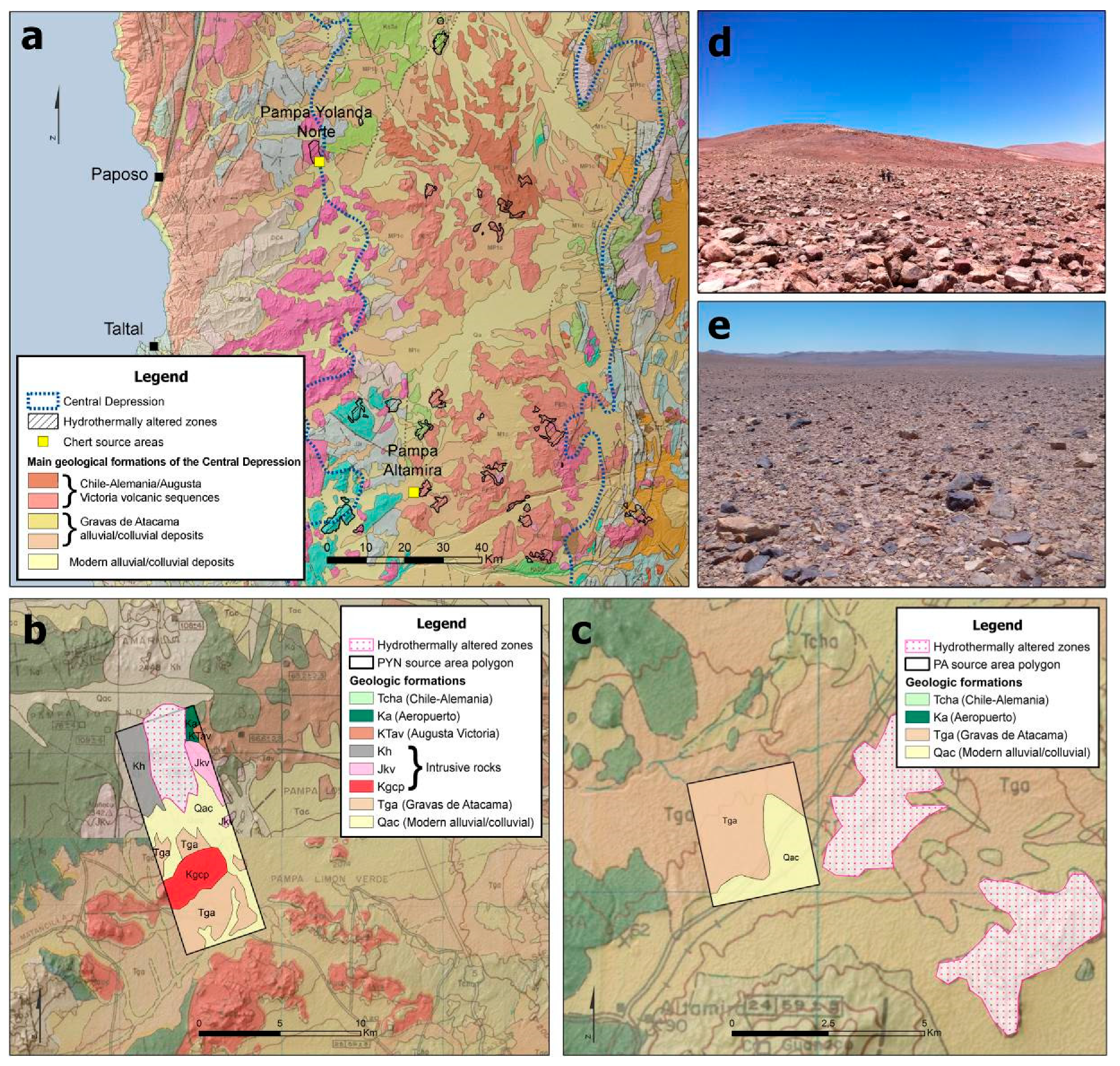
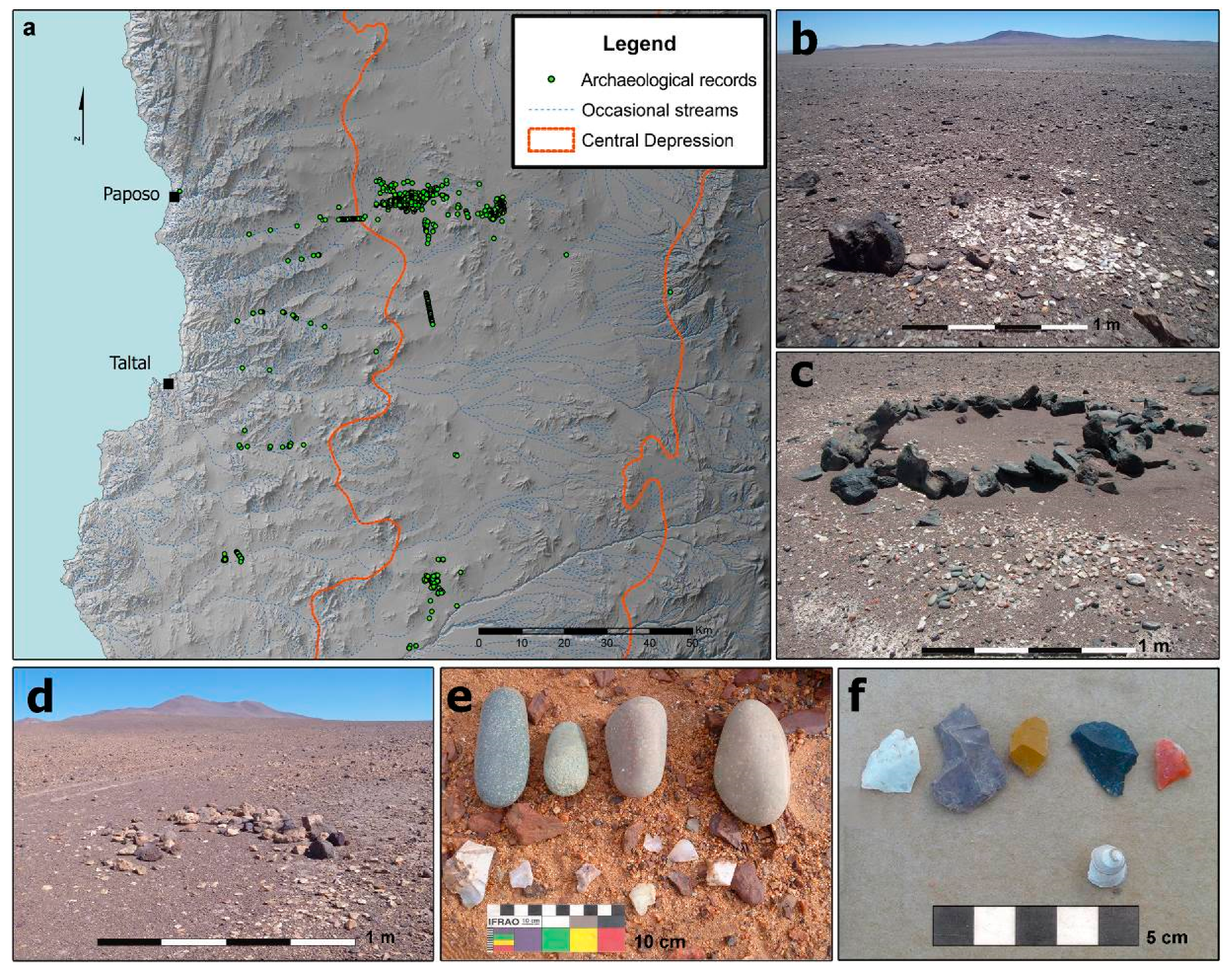
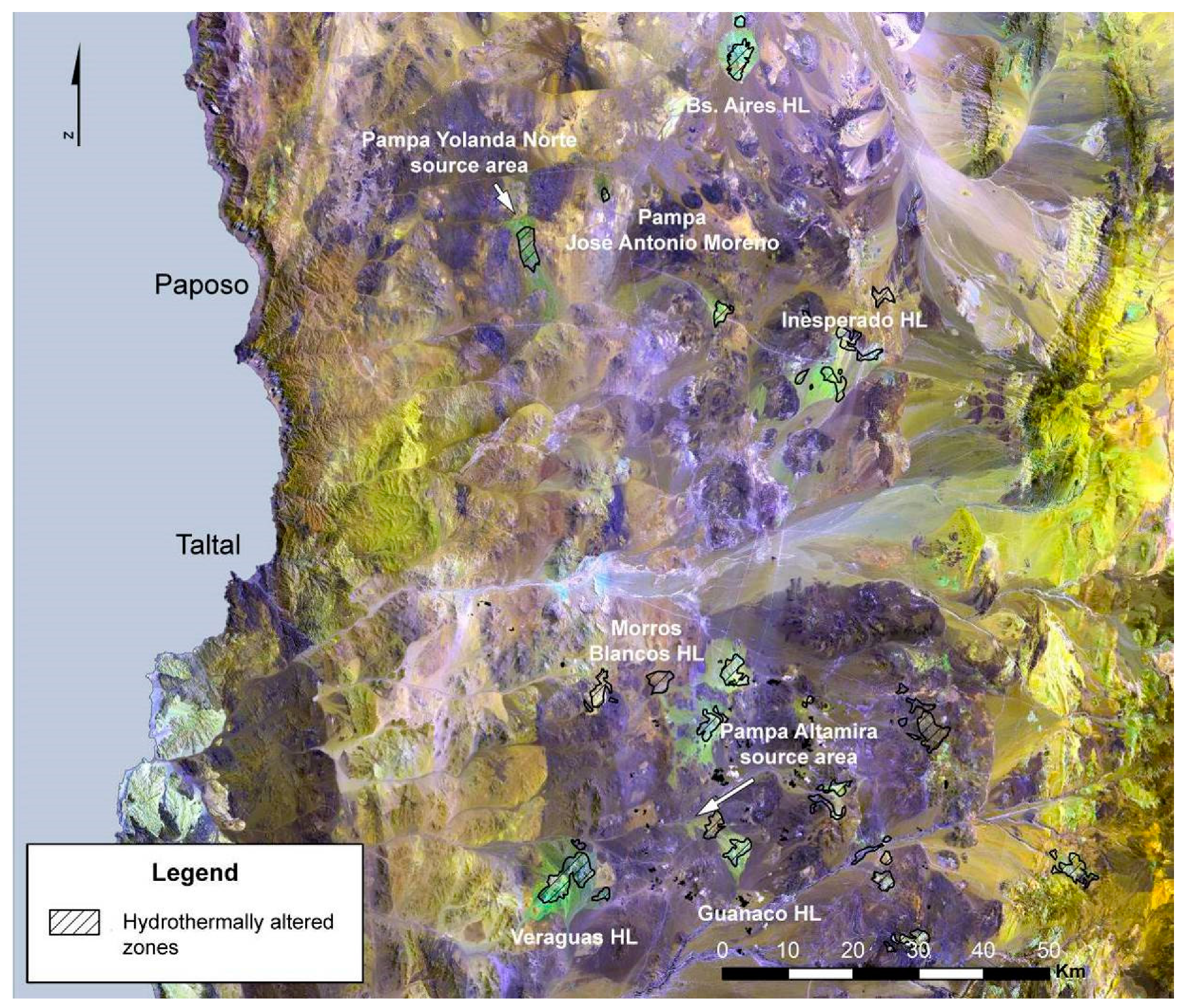
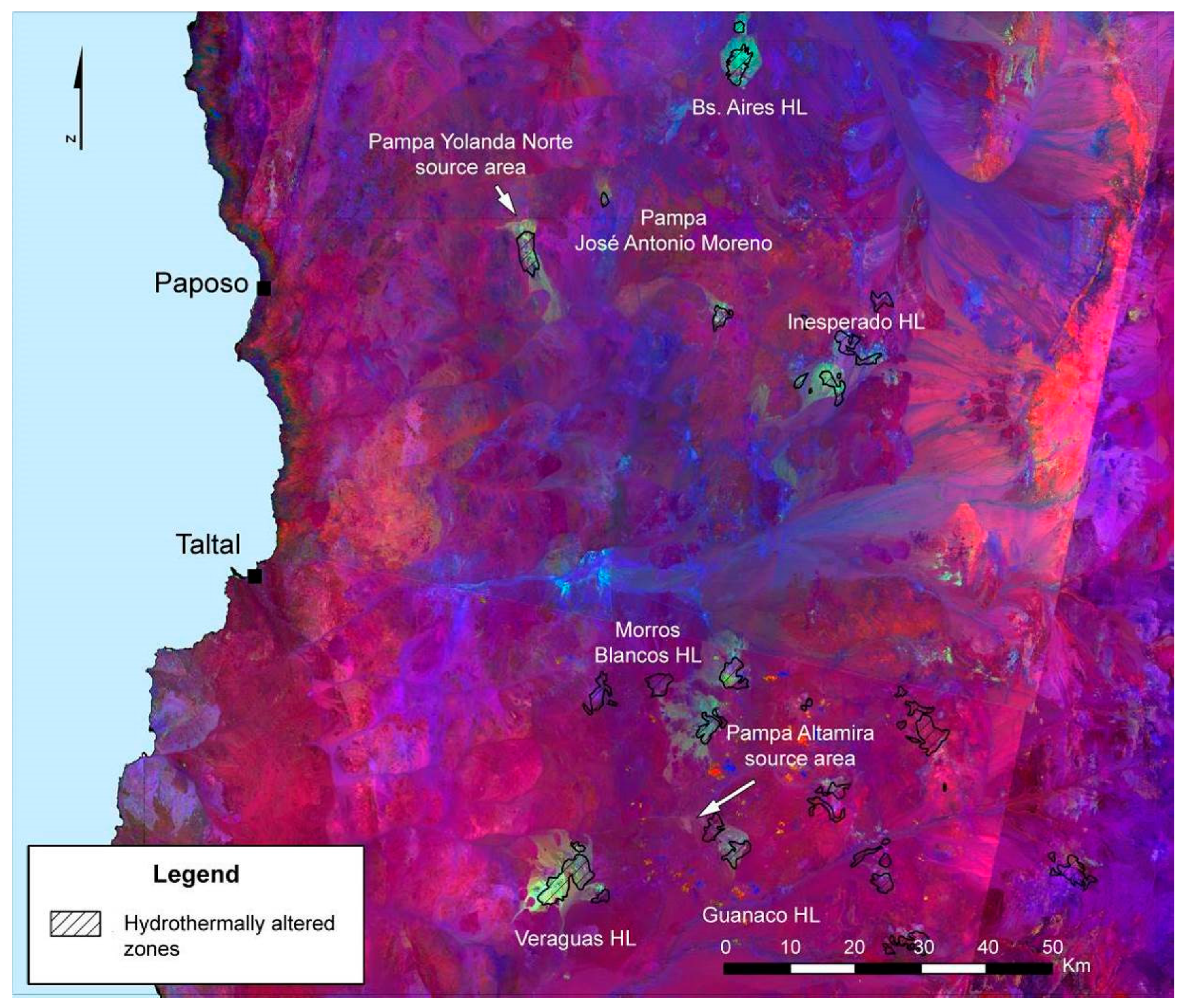
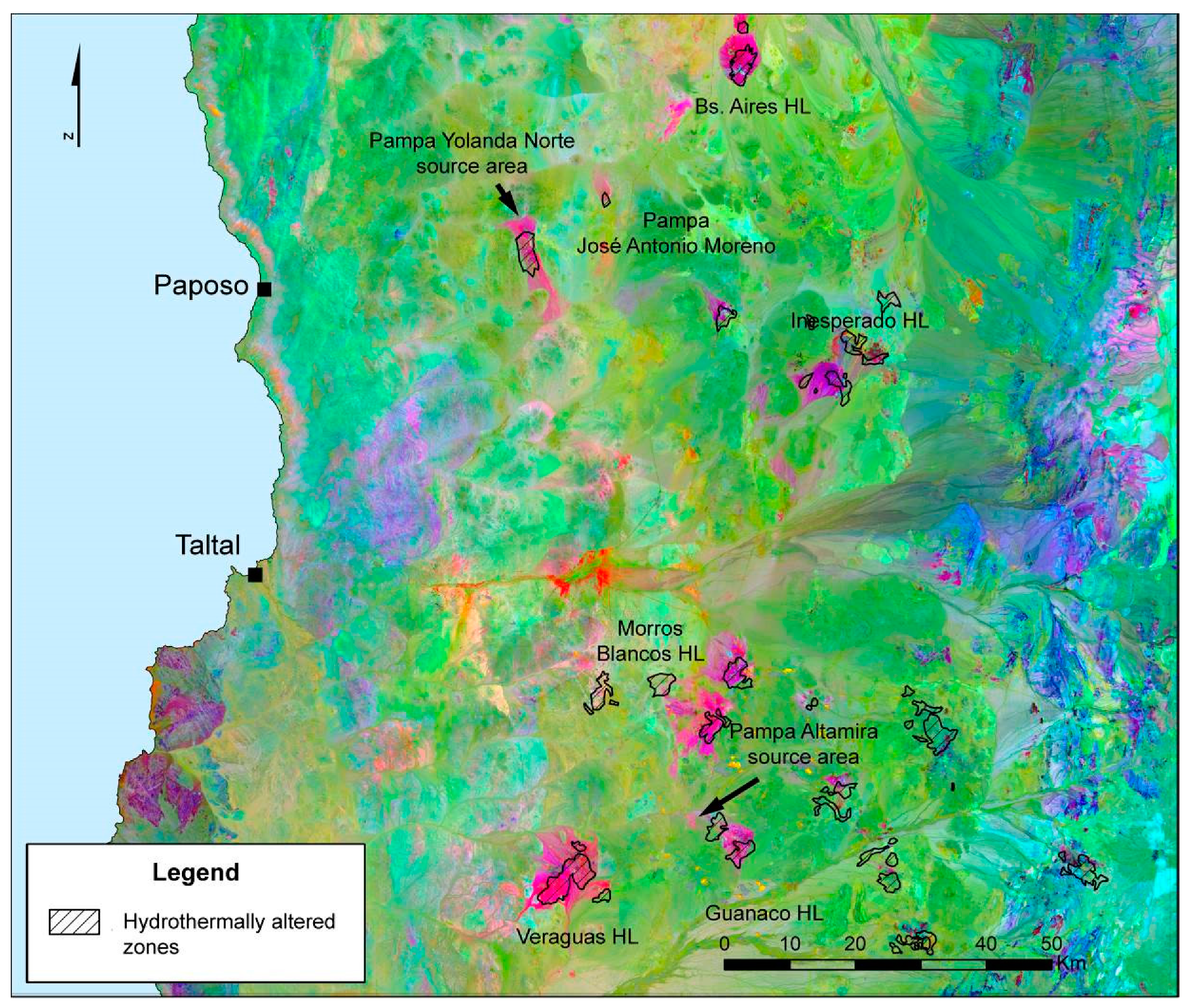
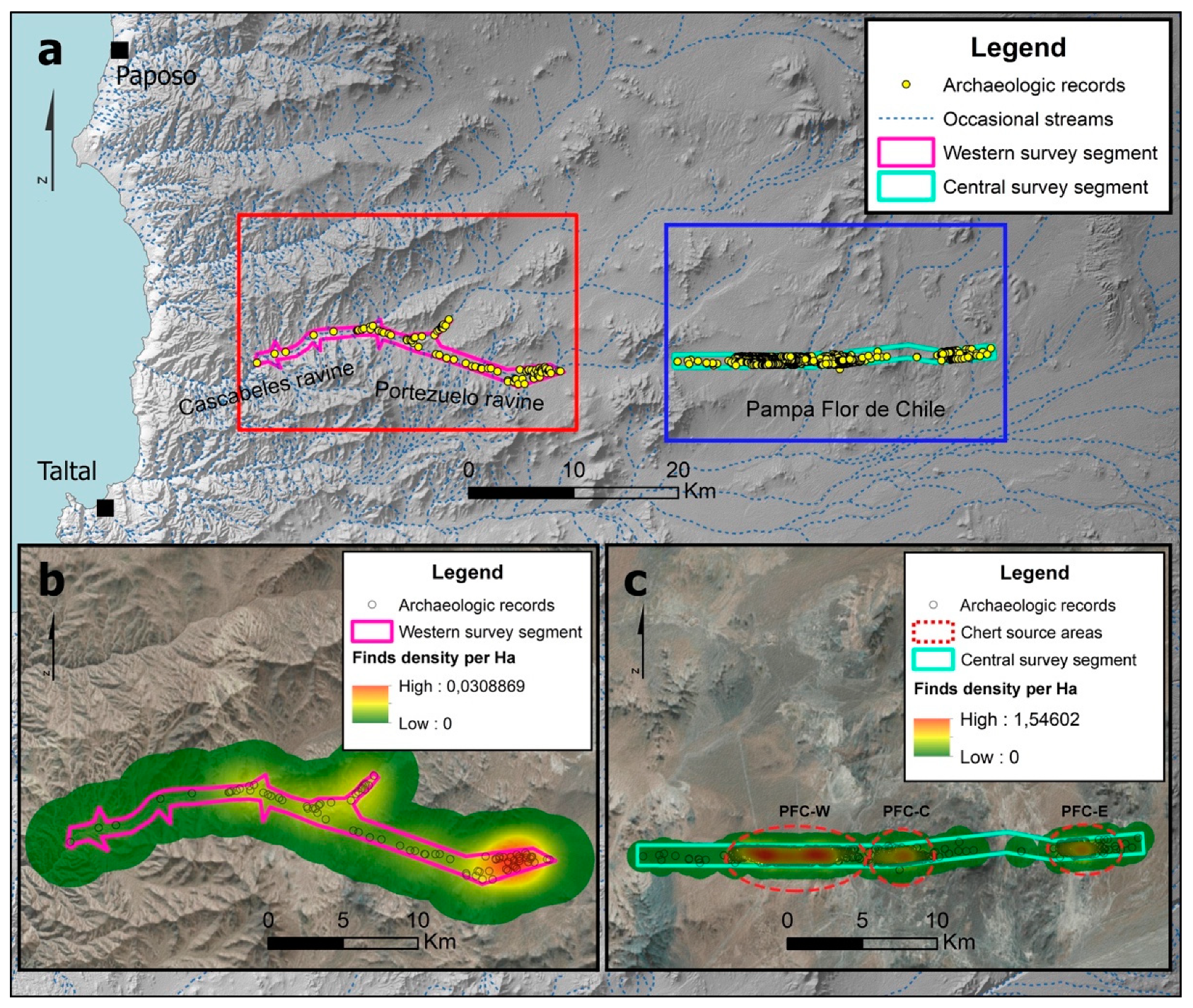
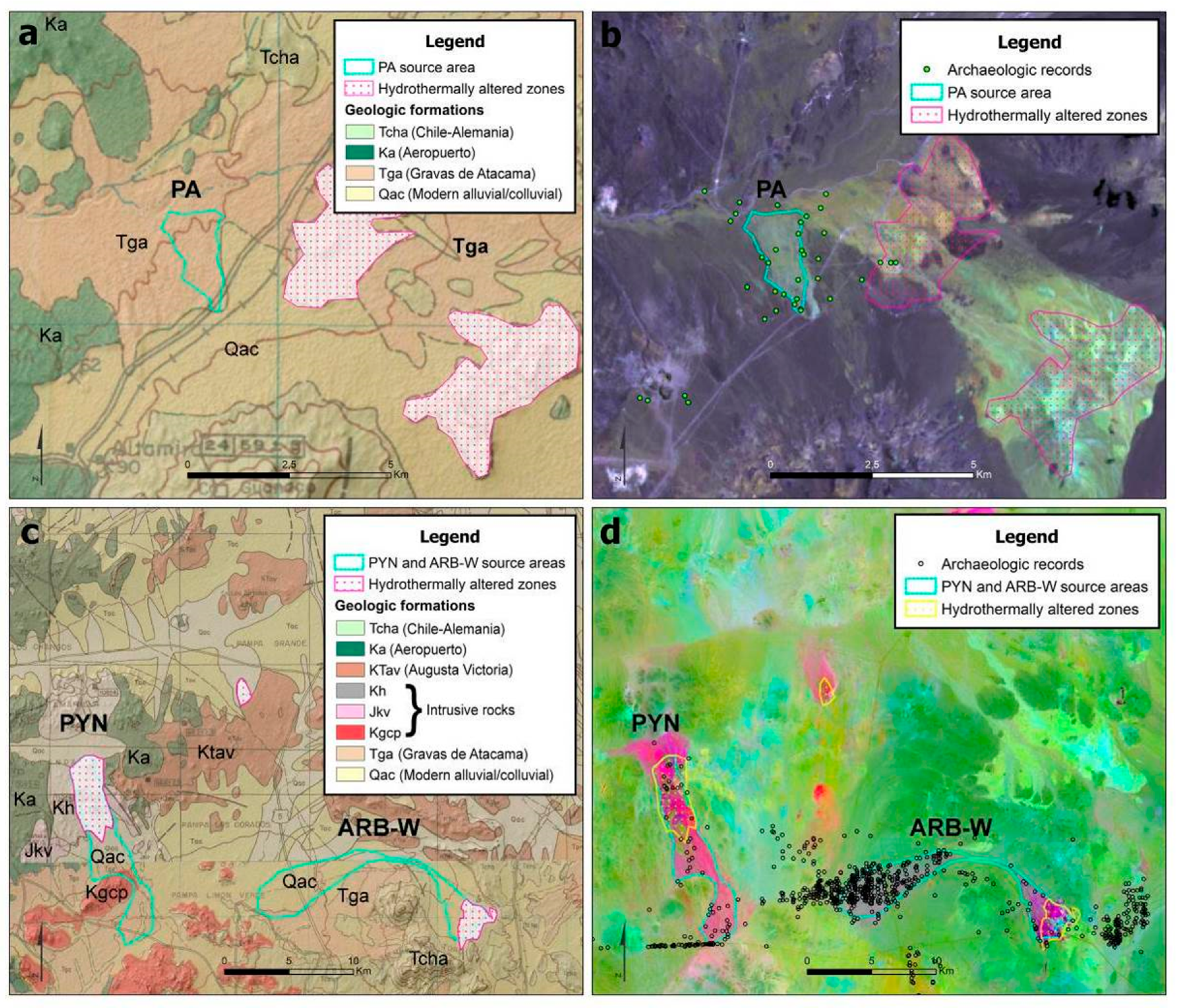
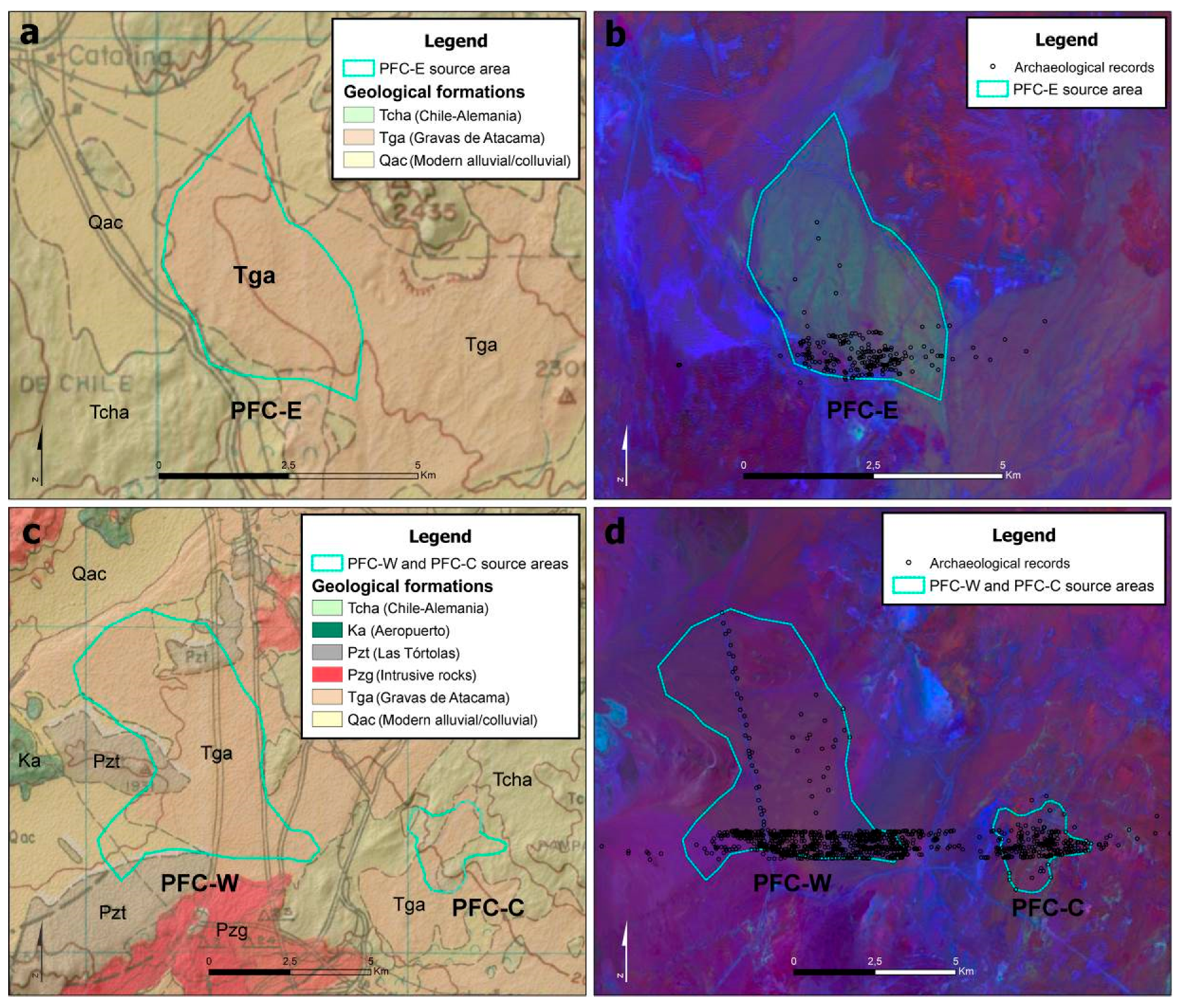
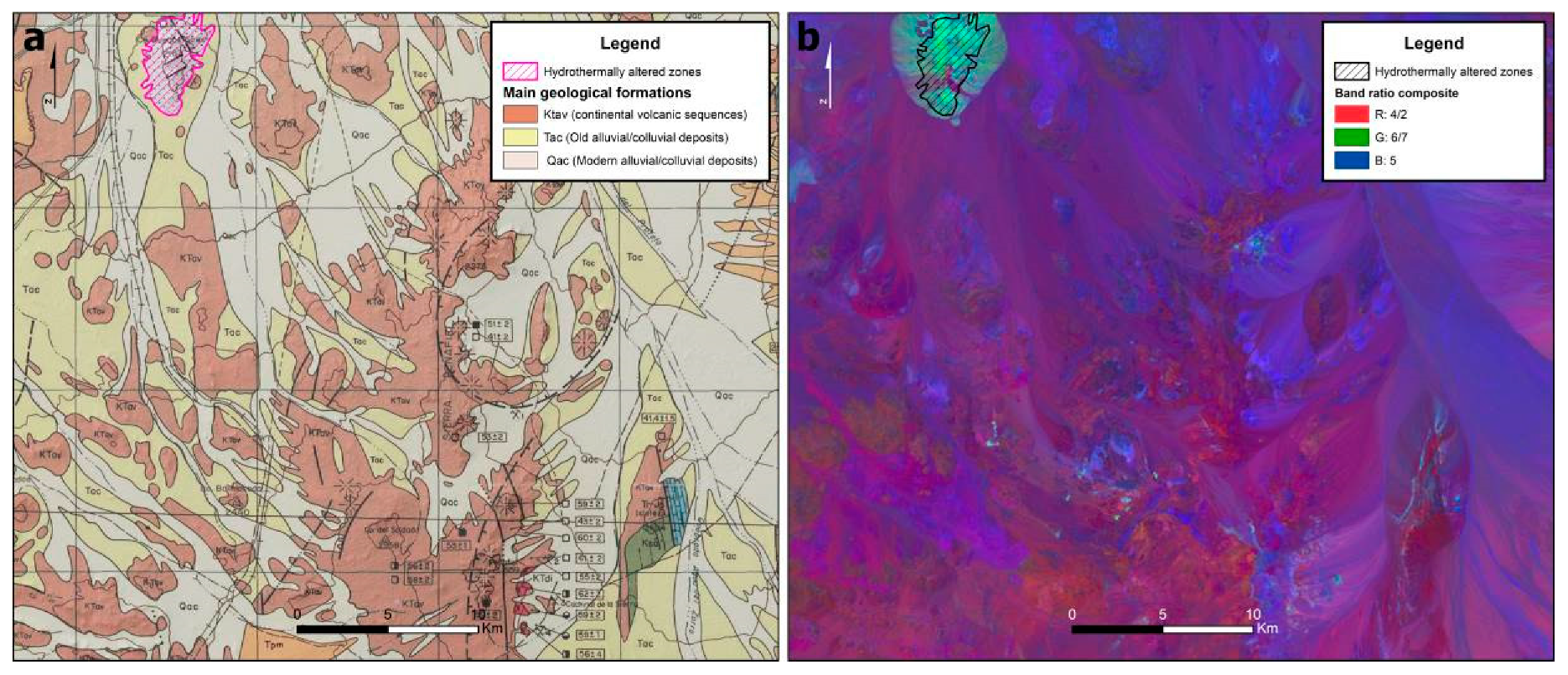
| Eigenvector/PC | PC 1 | PC 2 | PC 3 | PC 4 | PC 5 | PC 6 |
|---|---|---|---|---|---|---|
| Eigenvector 1 | 0.170988 | −0.451865 | −0.62058 | 0.0738699 | 0.521468 | 0.322607 |
| Eigenvector 2 | 0.277532 | −0.446888 | −0.314157 | −0.111879 | −0.43326 | −0.651415 |
| Eigenvector 3 | 0.374354 | −0.396037 | 0.301608 | −0.0688847 | −0.478003 | 0.61548 |
| Eigenvector 4 | 0.44429 | −0.246103 | 0.60082 | 0.115229 | 0.526232 | −0.301425 |
| Eigenvector 5 | 0.574989 | 0.480726 | −0.166831 | −0.63249 | 0.0927344 | 0.0425876 |
| Eigenvector 6 | 0.474966 | 0.384187 | −0.190792 | 0.750972 | −0.162328 | 0.00979504 |
© 2019 by the authors. Licensee MDPI, Basel, Switzerland. This article is an open access article distributed under the terms and conditions of the Creative Commons Attribution (CC BY) license (http://creativecommons.org/licenses/by/4.0/).
Share and Cite
Borie, C.; Parcero-Oubiña, C.; Kwon, Y.; Salazar, D.; Flores, C.; Olguín, L.; Andrade, P. Beyond Site Detection: The Role of Satellite Remote Sensing in Analysing Archaeological Problems. A Case Study in Lithic Resource Procurement in the Atacama Desert, Northern Chile. Remote Sens. 2019, 11, 869. https://doi.org/10.3390/rs11070869
Borie C, Parcero-Oubiña C, Kwon Y, Salazar D, Flores C, Olguín L, Andrade P. Beyond Site Detection: The Role of Satellite Remote Sensing in Analysing Archaeological Problems. A Case Study in Lithic Resource Procurement in the Atacama Desert, Northern Chile. Remote Sensing. 2019; 11(7):869. https://doi.org/10.3390/rs11070869
Chicago/Turabian StyleBorie, César, César Parcero-Oubiña, Youngsang Kwon, Diego Salazar, Carola Flores, Laura Olguín, and Pedro Andrade. 2019. "Beyond Site Detection: The Role of Satellite Remote Sensing in Analysing Archaeological Problems. A Case Study in Lithic Resource Procurement in the Atacama Desert, Northern Chile" Remote Sensing 11, no. 7: 869. https://doi.org/10.3390/rs11070869
APA StyleBorie, C., Parcero-Oubiña, C., Kwon, Y., Salazar, D., Flores, C., Olguín, L., & Andrade, P. (2019). Beyond Site Detection: The Role of Satellite Remote Sensing in Analysing Archaeological Problems. A Case Study in Lithic Resource Procurement in the Atacama Desert, Northern Chile. Remote Sensing, 11(7), 869. https://doi.org/10.3390/rs11070869





